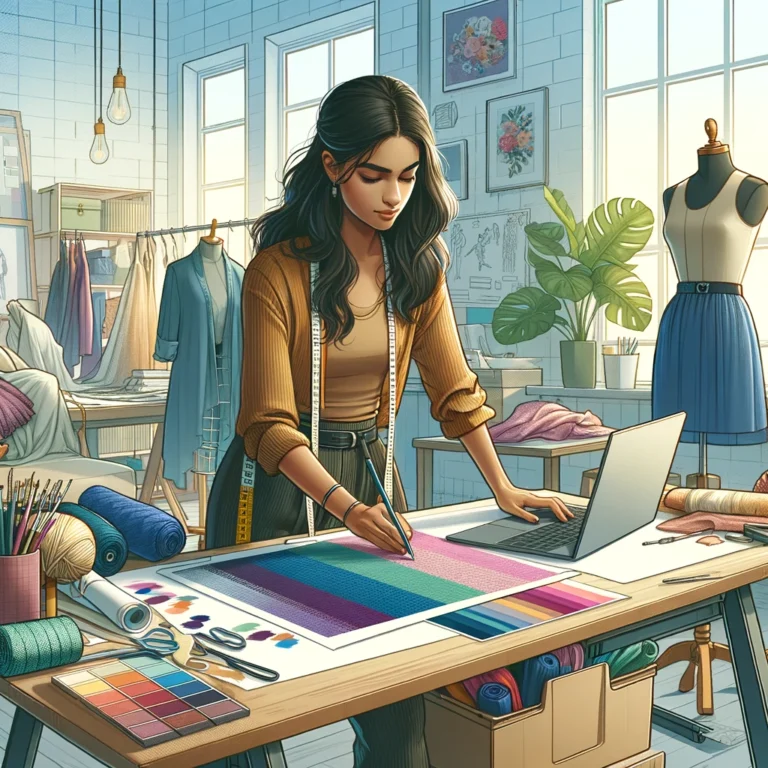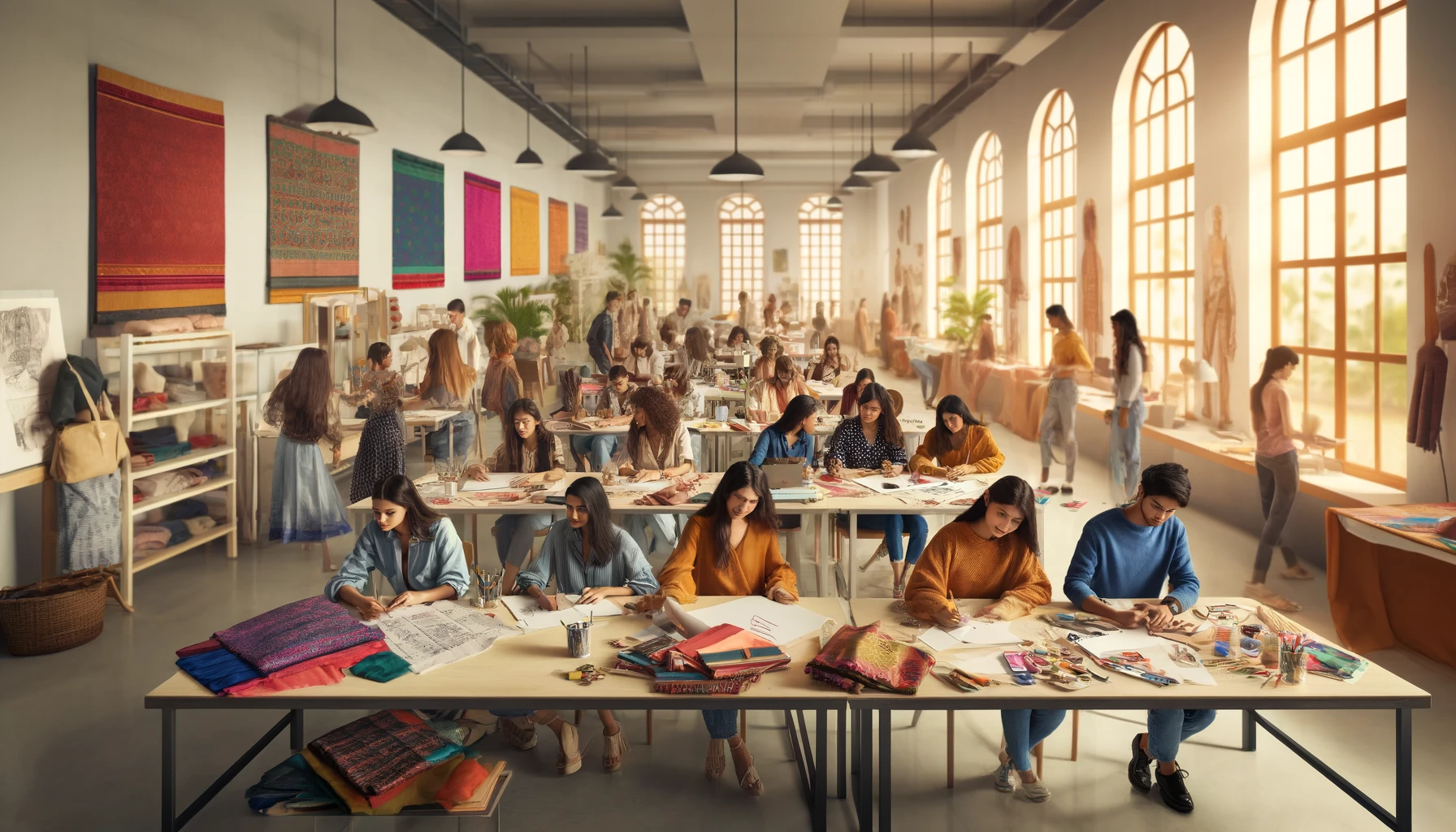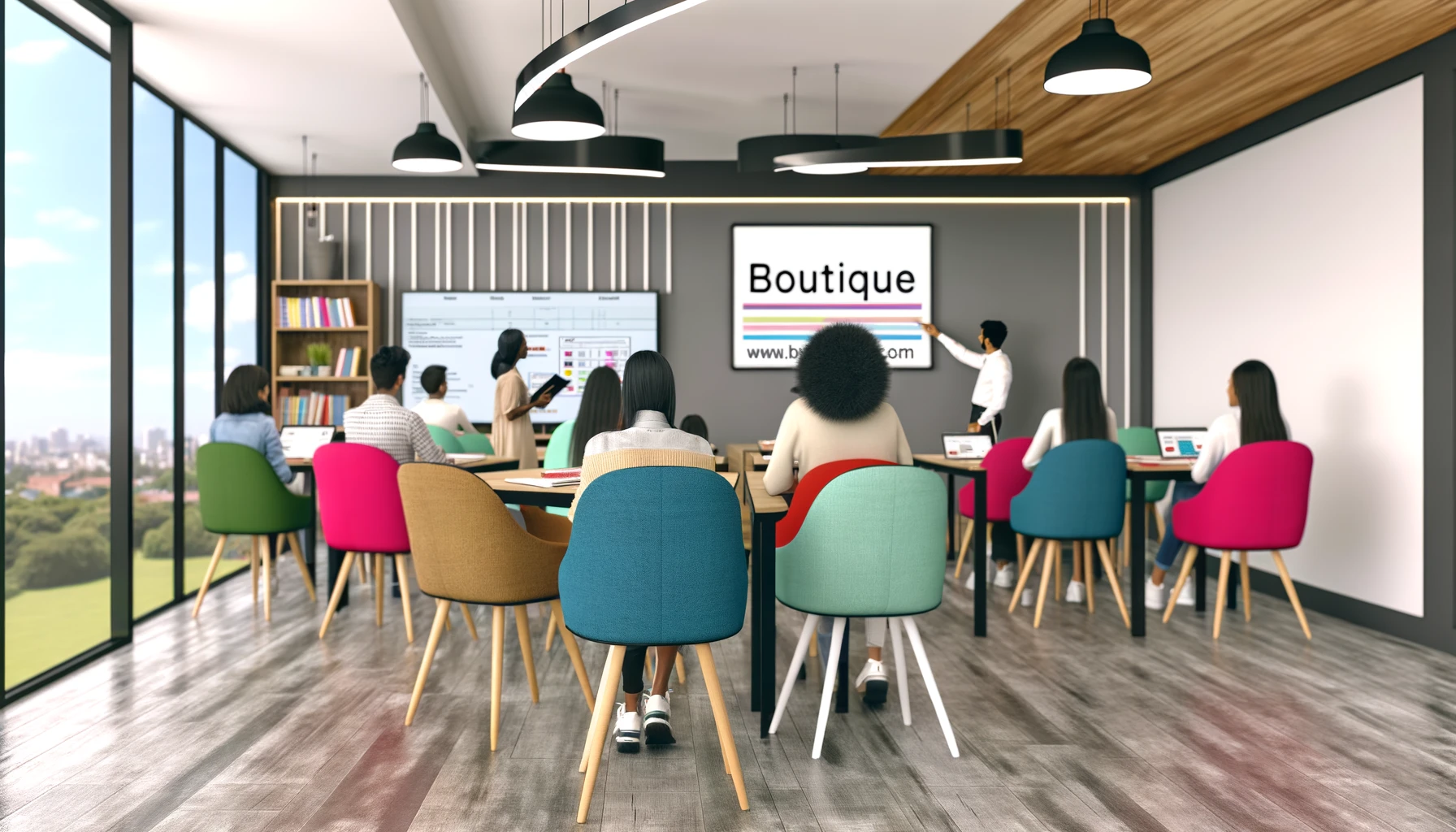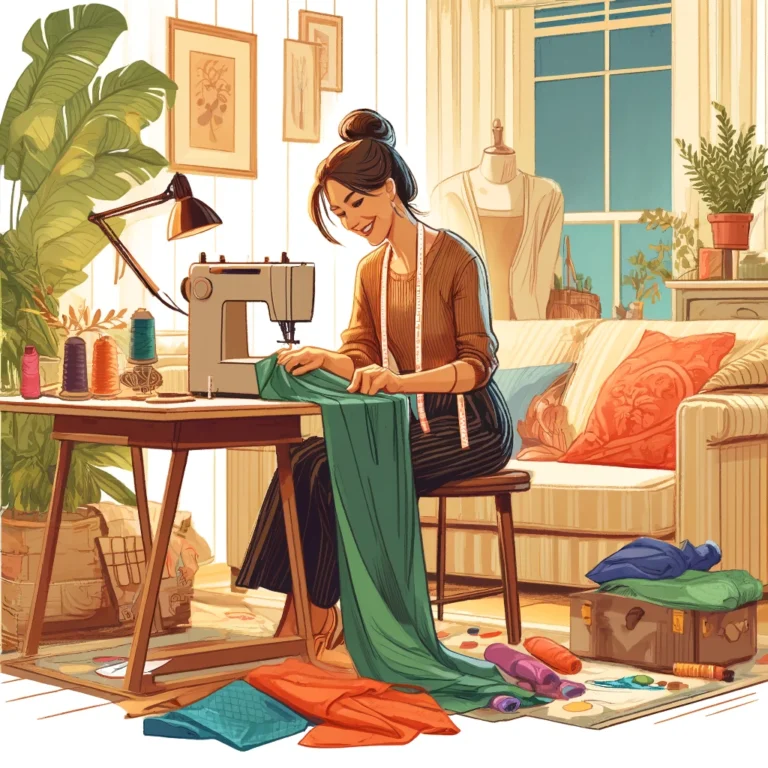
Online Fashion Design Courses in India for Beginners
info
May 14, 2024
Introduction
Are you dreaming of a career in fashion design but not sure where to start? Online fashion design courses in India for beginners are an excellent gateway into this vibrant industry. These courses are designed to be accessible, allowing you to learn the fundamentals of fashion design from anywhere at any time. But with so many options available, how do you choose the right one for you?
In this guide, we will explore key factors to consider when selecting an online fashion design course. From understanding the curriculum to assessing the flexibility of course schedules, we’ll ensure you have all the information you need to make an informed decision. Whether you’re looking to express your creativity or aiming for a career change, the right course can set the foundation for your success in the fashion world. Let’s begin this stylish journey together!

Understanding Your Fashion Design Goals
Before diving into the plethora of online fashion design courses in India for beginners, it’s crucial to reflect on what you hope to achieve through your studies. Are you looking to become a professional fashion designer, or are you exploring fashion design as a hobby? Understanding your goals will guide you in choosing a course that aligns with your aspirations and provides the skills you need.
Identify Your Interests and Aspiration
- Career vs. Hobby: Determine whether you are pursuing fashion design as a potential career or simply as a creative outlet. This will influence the type of course you choose, whether it’s more comprehensive and professional or more casual and introductory.
- Specializations: Fashion design is a broad field encompassing areas like womenswear, menswear, children’s wear, and accessories. Think about which area excites you the most.
Set Realistic Goals
- Short-term Goals: What skills do you hope to acquire in the next few months? Perhaps you want to learn basic sketching techniques or understand fabric types.
- Long-term Aspirations: Are you aiming to launch your own fashion line or work for a major fashion brand? Knowing this can help you select a course that covers relevant topics such as fashion business management or advanced design techniques.
Research Potential Career Paths
- Explore different roles within the fashion industry, such as stylist, pattern maker, or fashion marketer. Each role might require a different set of skills and courses.
- Consider the market demand and career opportunities in the fashion sector, especially in regions you are interested in working.
By clearly defining your fashion design goals, you ensure that the online course you choose not only teaches you the basics but also propels you towards your desired career path. This alignment is crucial for your motivation and success in the field of fashion design.
Navigating Your Options: Evaluating Online Fashion Design Courses in India
When exploring online fashion design courses, particularly for beginners in India, it’s important to consider reputable institutions like the National Institute of Fashion Technology (NIFT), along with emerging educational platforms such as those offered by renowned designer Manish Malhotra, and the Leela Institute of Professional Studies, Jaipur.
Overview of Top Online Fashion Design Courses Available in India
- National Institute of Fashion Technology (NIFT): Established in 1986 under the aegis of the Ministry of Textiles, Government of India, NIFT stands as a premier institute of fashion education. It offers a wide range of programs from bachelor’s degrees to doctoral studies in fields such as fashion design, management, and technology. NIFT is known for its extensive curriculum that incorporates practical skills and theoretical knowledge, aimed at providing a holistic education in fashion.
- Leela Institute of Professional Studies, Jaipur: Leela Institute of Professional Studies, Jaipur, renowned as one of India’s premier fashion design institutes, was established in 2013. It stands out for offering comprehensive courses in Fashion, Interior, Graphic, Website Design, and Digital Marketing, both through online and offline modes. To delve deeper into the offerings and learn more about LIPS Global, please visit their website at www.lipsglobal.com.
- Manish Malhotra: This platform offers specialized courses in fashion design, providing insights into contemporary high fashion and the dynamics of the fashion industry led by a leading designer. These courses are particularly appealing for those looking to delve into the glamorous world of celebrity fashion design.
- Pearl Academy: As a leading design institute, Pearl Academy facilitates courses that blend contemporary trends with traditional fashion elements. It’s recognized for its progressive curriculum and international exposure.
Criteria For Evaluating Courses
When choosing the right course, consider the following criteria to ensure it meets your educational and professional aspirations:
- Accreditation and Recognition: Verify that the course is recognized by appropriate educational authorities and acclaimed within the industry. This recognition is a testament to the quality and relevance of the education provided.
- Curriculum and Specialization Areas: Examine whether the course covers essential skills in fashion design, including both foundational and advanced topics. Specializations such as textile design, fashion marketing, or luxury brand management are important depending on your career goals.
- Faculty Expertise and Industry Connections: Consider the experience and qualifications of the faculty as well as the institute’s connections with the fashion industry. Opportunities for internships, workshops, and real-world projects are invaluable for gaining practical experience and networking.
- Facilities and Resources: Check for the availability of state-of-the-art facilities and resources such as design labs, libraries, and digital tools that are crucial for a comprehensive learning experience in fashion design.
Choosing the right online fashion design course requires careful consideration of these factors to ensure that your education leads you towards a successful career in fashion.
Course Content and Structure
When choosing an online fashion design course, understanding the course content and how it’s structured is crucial. This insight will help you determine if the course will meet your educational needs and how well it fits into your current lifestyle and learning preferences
Key Components of Course Content
- Foundation Modules: Most courses start with basic concepts in fashion design, including drawing, color theory, and textile fundamentals. These foundational skills are essential for building your knowledge base.
- Specialized Topics: As you progress, courses should offer specialized modules that align with current industry trends and technologies, such as sustainable fashion, digital fashion design techniques, and fashion marketing.
- Practical Skills Development: Look for courses that emphasize practical skills, such as pattern making, draping, and the use of fashion design software like Adobe Photoshop, Adobe Illustrator and Optitex.
- Project Work: The inclusion of project work or a capstone project is important as it gives you the opportunity to apply what you’ve learned in a practical setting, which can be crucial for your portfolio development.
Video demonstrating how to create a flat drawing using Adobe Illustrator for Beginners
Video demonstrating Basics of Fashion Design using Photoshop For Beginners
Structure of the Online Fashion Design Courses
- Duration and Flexibility: Course lengths can vary from a few months to several years, depending on the level of certification or degree offered. Check if the course offers part-time learning options or self-paced modules, which can be particularly beneficial if you’re balancing other commitments.
- Assessment Methods: Understand how your progress will be evaluated. This might include assignments, projects, exams, or a combination of these. Continuous assessment can provide ongoing feedback and is often more suited to creative disciplines like fashion design.
- Interactive Elements: Courses that include interactive elements such as live tutorials, forums, and group projects can enhance your learning experience by allowing you to engage with peers and instructors.
- Resource Access: Ensure that the course provides sufficient resources, such as digital libraries, lecture materials, and access to design software, which are crucial for completing your studies successfully.
- Support Services: Good courses offer comprehensive support through academic advising, technical support, and career counselling services to help students navigate through their education and into their careers.
Understanding the content and structure of an online fashion design course is vital to ensuring it meets your expectations and needs. This will also prepare you for what to expect throughout your educational journey, helping you make the most of your learning experience.
Tailoring Your Learning: Flexibility and Environment in Online Fashion Design Courses
When exploring online fashion design courses in India for beginners, understanding the flexibility and learning environment offered by the course is essential. This consideration is particularly important for those who need to balance learning with other life commitments or prefer a learning style that deviates from the traditional classroom setting.
Flexibility of Online Learning
- Scheduling: Online courses often allow you to choose when you engage with the material, whether that’s early in the morning or late at night. This flexibility can make learning more accessible if you are juggling responsibilities like work or family.
- Pacing: Many online courses offer self-paced learning, which means you can move through the material at a speed that suits your learning style and schedule. This is ideal for those who might need extra time to absorb complex concepts or, conversely, for those who wish to progress more quickly.
- Course Duration: The length of online courses can vary significantly, from intensive short courses to longer, more detailed programs. Understanding the time commitment required is crucial when planning your education journey.
Learning Environment
- Interactive Platforms: Look for courses that use interactive platforms which can enhance your learning experience. These platforms might include video tutorials, real-time discussions with instructors, or collaborative projects with fellow students.
- Support Systems: Robust support systems are essential in online learning environments. This includes access to tutors, peer interaction, and technical support, ensuring you never feel isolated despite the physical distance from your instructors and classmates.
- Resource Accessibility: Ensure the course provides continuous access to learning materials, including recorded lectures, digital libraries, and design software. This access allows you to learn and create at your own pace and on your own schedule.
- Practical Experience: Although online, some courses offer virtual internships or real-world project collaborations that can provide necessary practical experience in fashion design.
Choosing an online fashion design course that offers the right mix of flexibility and a supportive learning environment can significantly enhance your educational experience, making it more enjoyable and aligned with your personal and professional goals.
Understanding Resources and Support Systems
For beginners diving into online fashion design courses in India, the availability and quality of resources and support systems are pivotal. These elements ensure that students not only acquire knowledge but also feel guided and supported throughout their educational journey.
Essential Resources for Online Learning
- Digital Libraries and Materials: High-quality online courses provide access to extensive digital libraries that include e-books, research papers, fashion magazines, and trend reports. These resources are invaluable for understanding both historical and contemporary design practices.
- Design Software and Tools: Access to industry-standard design software such as Adobe Illustrator, Photoshop, and CAD tools is essential. Some courses may provide these tools as part of the tuition or at a discounted rate for students.
- Video Content and Demonstrations: Courses should offer comprehensive video tutorials and step-by-step demonstrations that mimic the classroom experience, making complex techniques easier to understand and replicate.
Essential Resources for Online Learning
- Academic Advising: Dedicated academic advisors can help you navigate your educational path, assist with course selection, and provide career guidance. This support is crucial in aligning your coursework with your career aspirations.
- Technical Support: Reliable technical support is essential, especially for students who are new to online learning platforms or digital design tools. Quick and effective technical assistance ensures that technical issues do not hinder your learning process.
- Peer and Community Forums: Online discussion forums and community groups foster a sense of belonging and provide a platform for peer interaction, idea exchange, and networking. These communities can be vital for collaborative projects and for building professional connections.
- Tutoring and Mentorship Programs: Some institutions offer direct access to tutoring from experienced designers and mentors. This one-on-one interaction can be incredibly beneficial for personalized feedback and professional development.
- Career Services: Comprehensive career services including resume reviews, internship placement assistance, and job search resources are crucial. These services prepare students for the job market and help them secure positions that match their skills and ambitions.
By ensuring that these resources and support systems are in place, online fashion design courses can provide a robust educational experience that equips students with the skills and confidence needed to succeed in the dynamic field of fashion design.
Building Skills: Practical Experience and Portfolio Development in Online Fashion Design Courses
For students enrolled in online fashion design courses in India, gaining practical experience and developing a strong portfolio are crucial steps toward launching a successful career. These elements not only enhance learning but also showcase your skills to potential employers or clients.
Gaining Practical Experience
- Virtual Internships: Many online courses partner with fashion brands and design houses to offer virtual internships. These opportunities allow you to work on real projects under the guidance of experienced professionals, providing invaluable industry exposure.
- Live Project Assignments: Courses often include live projects that simulate real-world challenges. These projects require you to apply your learning to design solutions, helping you understand the practical implications of your theoretical knowledge.
- Collaborative Workshops: Participating in online workshops or group projects can offer hands-on experience and also foster teamwork skills. These sessions often involve collaborative problem-solving with peers, which is a key skill in the fashion industry.
Portfolio Development

- Guided Portfolio Projects: Look for courses that include a portfolio development component. These projects are specifically designed to help you build a professional portfolio that showcases your best work.
- Feedback and Critiques: Regular feedback from instructors and industry professionals is vital for refining your work. Constructive critiques can help you improve and polish your designs to meet professional standards.
- Exposure to Diverse Styles and Techniques: Diverse assignments that challenge you to work with different styles and techniques can enrich your portfolio, demonstrating your versatility and creativity to potential employers.
- Digital Presentation Skills: Since most portfolios are now presented in digital format, it’s important that courses teach skills related to digital presentation, including graphic design and web portfolio development.
By focusing on practical experience and portfolio development, online fashion design courses equip you with not just the knowledge but also the practical skills necessary for a successful career in fashion design. These experiences are vital for building confidence and helping you stand out in the competitive fashion industry.
Budgeting for Success: Cost Considerations in Online Fashion Design Courses
When planning to enroll in online fashion design courses in India, understanding and managing cost considerations is crucial. The overall expenses can vary significantly based on several factors, from the type of institution to the length and depth of the course offered.

Types of Costs Associated with Online Fashion Design Courses
- Tuition Fees: This is typically the most significant expense. Tuition can vary widely depending on the institution’s prestige, the course’s duration, and the level of specialization. Some courses might offer payment plans or scholarships to help manage these costs.
- Software and Equipment: Many fashion design courses require professional design software, which can be costly. Additionally, you may need to invest in hardware like a good-quality computer and a drawing tablet.
- Materials and Supplies: Although online courses reduce the need for physical materials, you may still need to purchase certain items like fabrics and drafting tools for practical assignments.
- Registration and Examination Fees: Some courses might have additional costs for registration, examinations, or certification.
Financial Aid and Scholarships
- Scholarships: Many educational institutions offer scholarships based on merit or financial need. These can significantly reduce the financial burden of tuition fees.
- Educational Loans: Banks and financial institutions often provide student loans at competitive interest rates, which can be an option to finance your education.
- Work-Study Programs: Some schools offer work-study programs that allow you to work part-time, often within the institution, to earn money while studying.
Evaluating Return on Investment
- Employment Prospects: Consider the employability and income potential post-completion of the course. Programs with strong industry links and internship opportunities might offer better employment prospects.
- Long-Term Benefits: Evaluate the potential long-term benefits of the course. For example, courses that offer widely recognized certifications or degrees may open more doors and warrant a higher initial investment.
- Personal and Professional Growth: Beyond immediate financial returns, consider the value of personal satisfaction and professional growth. The right course can set the stage for lifelong career fulfillment in the fashion industry.
Understanding these cost considerations and exploring financial aid options can help you make an informed decision about investing in an online fashion design course. It’s important to balance affordability with the quality and potential benefits of the education you are receiving to ensure it aligns with your career goals and financial situation.
Learning from Experience: Student Reviews and Outcomes
When choosing an online fashion design course, one of the best ways to gauge the quality and effectiveness of the program is by examining student reviews and outcomes. These insights can provide real-world evidence of how the course has impacted past students’ careers and personal growth.
Importance of Student Reviews

- Student Satisfaction: Reviews can reflect student satisfaction with various aspects of the course, including the curriculum, teaching methods, and administrative support. They often highlight strengths and areas for improvement, giving you a clearer picture of what to expect.
- Engagement and Interaction: Comments on the level of interaction with faculty and other students can help you understand the course’s collaborative environment and networking opportunities.
- Technical Support: Reviews often include information about the responsiveness and effectiveness of technical support, which is crucial for online learning.
Analyzing Outcomes
- Career Advancement: Look for statistics or testimonials about students’ career progress post-completion. Many institutions publish data on job placements, salary increases, or career shifts that occurred as a result of the course.
- Portfolio Development: Outcomes related to portfolio improvements are particularly important in fashion design. Successful courses should help students build a professional portfolio that enhances their employability.
- Skill Enhancement: Testimonials might detail specific skills that students were able to develop or improve, which can be a good indicator of the course’s practical relevance.
Where to Find These Insights
- Official Course Websites: Most institutions will feature student testimonials and outcome statistics directly on their course pages.
- Educational Review Platforms: Websites like Course Report, GradReports, or Niche offer reviews and ratings from current and former students across various educational programs.
- Alumni Networks: Engaging with alumni through social media groups or alumni networks can provide unfiltered feedback and detailed insights into the course’s long-term impact on careers.
- Online Forums and Social Media: Platforms like Reddit, Quora, and LinkedIn can be useful for finding unsolicited student opinions and discussions about specific courses.
Evaluating student reviews and outcomes allows you to make a more informed decision based on the experiences of those who have already walked the path you’re considering. It also helps set realistic expectations for what you can achieve through the course.
Making the Decision: Choosing the Right Online Fashion Design Courses
Deciding on the right online fashion design course requires careful consideration of your personal and professional goals, the course details, and real-world outcomes. Here’s a structured approach to help you make an informed decision.
Checklist for Final Evaluation
- Align Goals with Curriculum: Ensure the course content and specializations align with your career aspirations. Whether it’s becoming a fashion designer, merchandiser, or fashion marketer, the course should support your specific professional objectives.
- Review Accreditation and Recognition: Choose courses that are recognized and accredited by relevant educational authorities. This ensures the quality and acceptance of your qualification in the professional world.
- Consider Flexibility and Learning Style: If you require flexibility due to other commitments, ensure the course offers part-time learning or self-paced options that fit your schedule.
- Evaluate Resources and Support: Confirm that the course provides comprehensive resources and support systems, including access to design software, academic advising, and career services.
- Assess Cost vs. Benefit: Analyze the total cost of the course, including hidden expenses like software and materials, and weigh it against the potential career benefits and personal growth.
- Read Student Reviews and Outcomes: Look at reviews from former students to gauge their experiences and the tangible outcomes they achieved post-completion.
- Seek Advice from Industry Professionals: If possible, talk to current professionals in the fashion industry or instructors to get insider opinions about the course’s relevance and reputation.
Steps to Enroll
- Prepare Your Application: Gather all necessary documents, such as your educational qualifications, work experience, and any required creative portfolios.
- Apply for Financial Aid: If needed, apply for scholarships, grants, or student loans.
- Submit Your Application: Ensure your application is complete, accurate, and submitted before the deadline.
- Follow Up: After submitting your application, keep track of its status and prepare for any interviews or additional requirements.
Final Thoughts
Making the right choice in online fashion design courses will not only impact your educational experience but also your career trajectory in the fashion industry. Take your time to research thoroughly, consider all factors critically, and choose a course that best fits your personal and professional aspirations. Remember, the right education can set the foundation for a successful and fulfilling career in fashion design.
Conclusion
Initiating online fashion design courses in India represents a significant step towards fulfilling your creative and professional aspirations in the fashion industry. As you stand at this pivotal crossroad, equipped with comprehensive insights into various courses, from their content and structure to the flexibility and support they offer, you are well-prepared to make an educated decision.
The journey ahead promises to be one of transformation—shaping you from a beginner into a skilled fashion professional. The knowledge you gain will not only enhance your technical skills but also expand your understanding of the global fashion landscape. Remember, the choice you make now will influence your career trajectory and open doors to new opportunities.
Therefore, take this decision seriously. Consider all the factors discussed: align your goals with the course offerings, ensure the credibility and support of the program meet your needs, and balance the costs with the potential benefits. The right course will not just educate you; it will inspire and propel you into your future career in fashion.
As you move forward, stay committed to your learning journey, engage actively with all the resources available, and build a network within the fashion community. The world of fashion is dynamic and ever-evolving, and with the right foundation, you will be well on your way to making your mark.
Good luck as you begin this exciting chapter of your life, where creativity meets career, and dreams are stitched into reality
Take the Next Step in Your Fashion Journey
Are you ready to transform your passion for fashion into a thriving career? Start today with the right online fashion design course in India for beginners and build a foundation for success in the fashion industry. Here’s how you can begin:
- Research Your Options: Explore various courses that match your career goals and lifestyle.
- Connect with Admissions: Discuss your aspirations with admissions counselors and understand how their programs can aid your career.
- Visit Websites and Attend Webinars: Gain insights by visiting official course websites and attending webinars.
- Apply Now: Once you’ve chosen your ideal course, apply and take the first step on your creative journey.
This is your moment to shine. Enroll now and start designing your future in fashion. Let your creativity lead the way to a successful and fulfilling career. Transform your passion into your profession!
Recent Post



Dont Hesitate To Contact Us
Connect for inquiries, guidance, or to commence your educational journey. We are here to assist you.
Categories
Subscribe Our Newsletter
Stay updated. Subscribe to our newsletter for the latest trends, events, and exclusive insights delivered to your inbox
About Us
Discover excellence at Leela Institute of Professional Studies, Jaipur – the premier Fashion & Design Institute since 2013. Offering on-campus and online courses in Fashion, Interior, Graphic, Jewelry Design, Website Design, and Digital Marketing.
Quick Links
Work Hours
- Mon - Fri
- Sat - Sun
- 09.30 AM - 04.00 PM
- Closed





